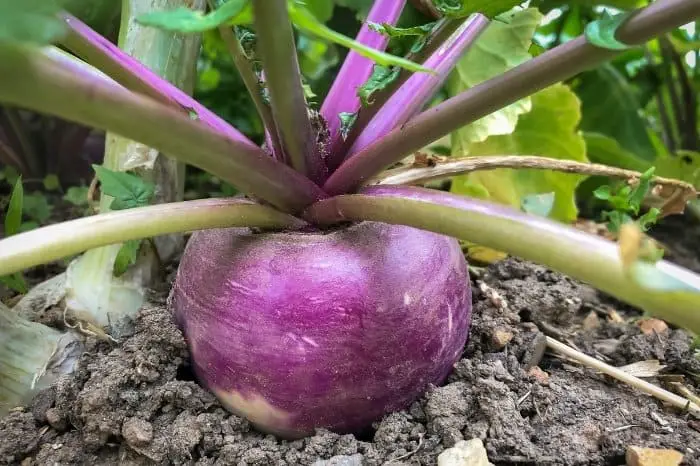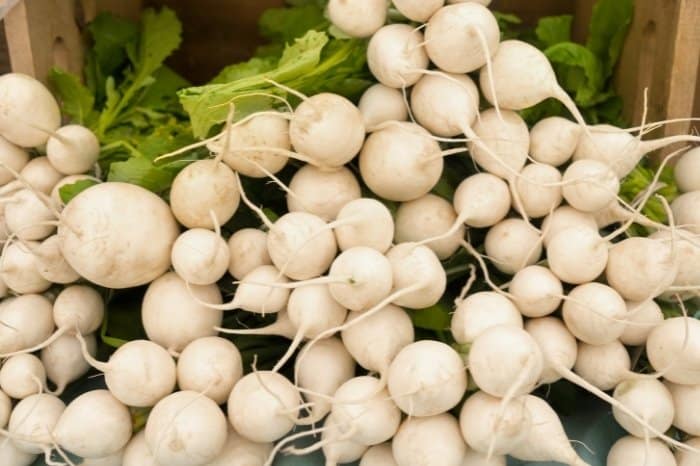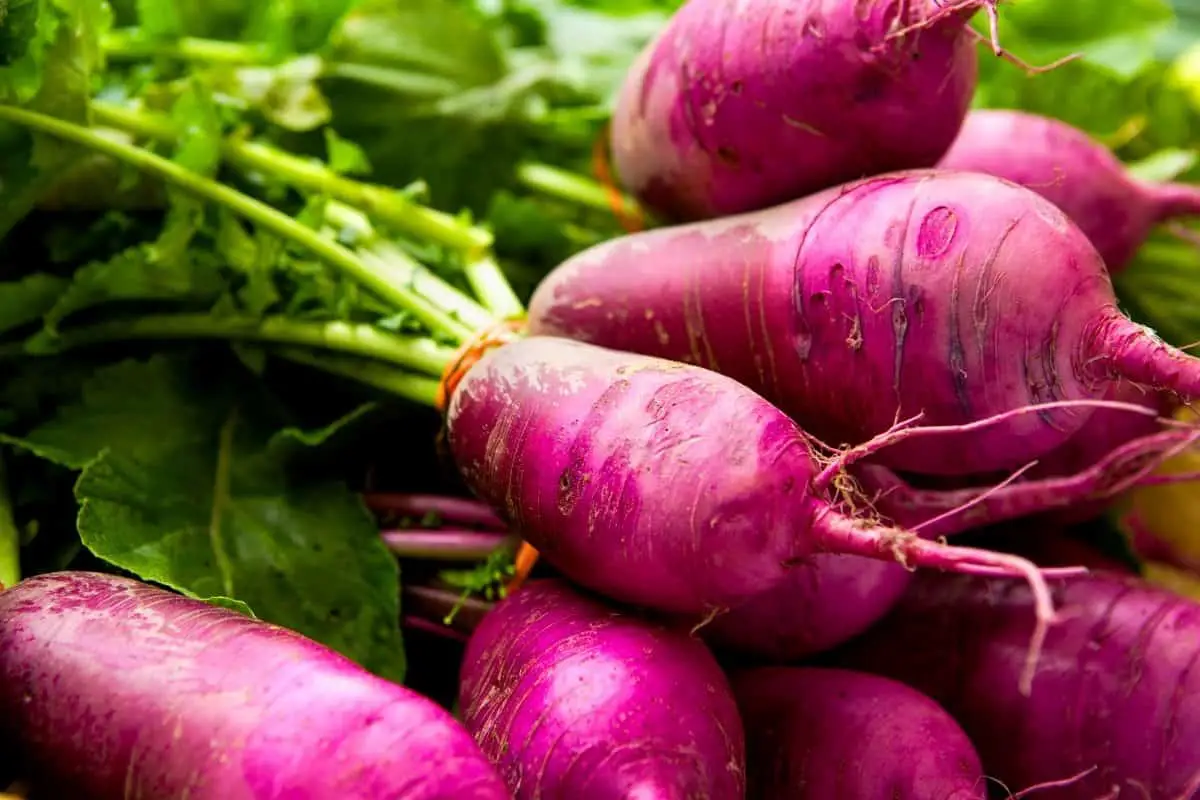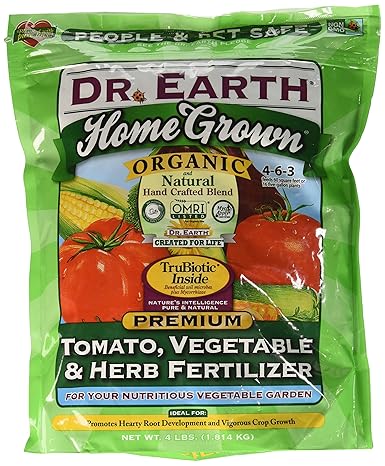Last Updated on January 29, 2022 by
Before planting, you need to know the best time to plant turnips and how long it takes them to grow from seed to maturity?
Turnips are cool-weather plants that enjoy the cool weather. Brassica Rapa, as it’s known scientifically, is a staple for both humans and livestock. The swollen turnip root is an enlarged stem that contains very high fiber, vitamins, and cancer-fighting compounds. You can eat it raw, stewed, mashed, boiled, or even mixed with other root crops.
The turnip leaves are high in vitamins, calcium, folate, thiamine, or iron and are cooked and eaten like kale or spinach.
Some farmers grow turnips to feed their livestock. They are also planted in the fall to attract deer in hunting areas.
What Is The Best Time To Plant Turnips?
The best time to plant turnips depends on the variety and growing turnips for roots or tops. Turnips take from 5 weeks to 2 months, from planting a seed to harvesting.
The crisp, round root thrives in cool weather, so you must calculate your days properly to ensure you sow your seeds once the soil warms up in the spring.
The turnip seeds require consistent warm temperatures above 40 degrees F. The warm weather helps them sprout quickly in a week or two. Be sure to wait until your temperatures are constantly at 40 degrees F to sow your seed.
Plant early enough before it gets hot. Too much heat causes roots to become woody and bitter-tasting. Turnips take five weeks to two months from planting a seed to harvest. The crisp, round root stems thrive in cool weather. You must plan when to plant and how to shield them from too much sun to get the best out of them.
If you are experiencing a cool season, continue to plant more seeds every two or three weeks to help you get a good succession harvest. This will help you avoid too many turnips at one time. The mature turnip can tolerate light freeze and actually taste sweeter after frost. However, stop planting at least two months into a hard freeze because it can kill turnips.
With that said, you can plant your seeds in March, April, or May. If there is enough time for a fall harvest, start a new round in early August, September, and October.
This is all dependent on local weather averages, so check your area weather forecast before planting.
Growing Turnips
There are two secrets to getting sweet turnips and yummy greens. They are:
- Plant turnips at the right time
- Get your seeds sprouted in warm soil and keeping your plants growing actively until harvest time.

This means taking good care of your plants by watering them properly during the dry season, thinning young plants to leave only the strong ones, creating more growing room, etc.
Plant your turnips in full sun in reasonably well-drained soil. Make sure your soil is dug at least 8 inches deep, and add compost for faster root development and growth. Scatter the seeds lightly, rake them into the topsoil, and water them lightly.
Harvest your turnips on time to ensure they are well grown. You can store them for up to two weeks in the fridge. You can pull larger roots out and cut off the tops and store them in a cool, dry place for months to come.
Read more about When is Kale Ready for Harvest
Caring For Your Turnips
Now that you know how to plant turnips, it’s important to look at how to grow turnips in terms of the care they need. Turnips require much care that you ought to give them. This includes:
Watering and Feeding. It is paramount to keep your soil moist and feed it with compost to help your turnips grow fast. Never allow your soil to dry out. When turnips grow slowly, they get woody and strong flavored. Add compost when planting turnips and side-dress them with aged compost at midseason.
Dr. Earth Organic 5 Tomato, Vegetable & Herb Fertilizer Poly Bag
Thinning and Weeding. Keep your turnip beds weed-free all the time. Overcrowding may cause your turnips to get stunted growth due to small roots. Thinning helps to remove the weak plants and provides ample space for the growing root. Mulch your turnips with straw to protect the growing tuber tops from sunburn.
Eliminate Pests. Flea beetles and aphids attack turnips, and they are easy to prevent—control aphids infestation by pinching out infested foliage. Weeds bring about flea beetles – keep your turnip garden free of weeds.
Fight off Diseases. Turnips are affected by diseases like white rust fungus that can cause small white cottony blisters on the upper surface of leaves. They also form a yellow discoloration on the undersides. Controlling these diseases before they form is beneficial.
Turnips Types You Can Plant
Turnips come in Royal Globe, Purple Top, Tokyo Express, Just Right, Market Express, Mild Hakurei, and Shogoin. These types are commonly grown for their greens. Here are three types that you can grow for the roots:
Oriental Hybrids
This type includes types like Hakurei and Market Express. They produce sweet, white roots, the size of a ping-pong ball in just four to five weeks. They are best for salads or stir-fries, and you can also eat them raw because they have a mild flavor. Because these roots are harvested while quite young, you can enjoy eating the greens as well in one swoop. You can eat them steamed, chopped, or freeze them for future use. Young turnip greens can be an alternative for spinach in most recipes. Red turnips like the Scarlet Ohno Revival and Scarlet Queen should be harvested early to avoid getting bitter as they age.

Yellow Turnips
This type goes under many different names. Most gardeners prefer the flavor of these golden turnip roots for grilling, braising, and roasting. If you want big, smooth roots, do not harvest greens from your yellow turnips to help the roots can grow steadily. The best time to harvest your yellow turnips is after the light frosts have passed.
Purple Top Turnips
This type has a purple top white globe. These are the best choice for the prolonged production of greens, and you can leave them in the ground all through winter. They will have pollinator-friendly yellow flowers in spring.
FAQs
How long does it take turnips to mature after planting?
You can plant turnips as early as late April and you will have a good crop of turnips by mid July. Turnips are a cool weather crop and can tolerate temperatures as low as 35 degrees F. They do not need any fertilizer or added moisture, but they do like a good deep watering in the spring.
urnips are also easy to grow and care for. They are easy to harvest, and the leaves and stems can be used in cooking. If you have too many turnips, they can be used as a winter vegetable in the garden. Just pick them when they get too big. You can even freeze them.
What is the best fertilizer for turnips?
The best way to fertilize turnips is to apply a nitrogen fertilizer when they are just beginning to flower. Turnips can be sown as early as mid-April and will do well if sown in early May. You can start them indoors or outdoors, but you should not plant them in the ground until the soil has warmed up.
Are turnips easy to grow?
Yes, they are. In fact, the whole family of brassicas (cabbages, kales, cauliflowers, etc.) are among the easiest vegetables to grow and tend to thrive in average conditions. They can be grown in any soil as long as it is well-drained and has good aeration.
Plant your seeds about 1 inch deep and 4 inches apart. Water them regularly and wait for them to sprout. When the first leaves appear, thin your plants to 10 inches apart. Keep the plants moist until they get their first true leaves. Thin the plants again after they begin to flower, but leave them about 2 inches apart.
How often do you water turnips?
To water your plants properly, make sure that you water the soil, not the leaves or stems. The soil should be dampened to a depth of 3 to 4 inches when it is dry and then allowed to drain freely. Water in the early morning or late evening to avoid overwatering. If you water in the afternoon, you may cause the plant's roots to rot from the excessive heat.
Do turnips need full sun?
It depends on the variety. Some varieties need a lot of sunlight to grow well, while others do fine with shade. However, most varieties are hardy to Zones 3 and 4.
How long does it take for turnips to germinate?
Turnips are a cool-season crop. That means that they require the ground to be warm (and preferably dry) in order for them to germinate, grow and mature. If you are planning on sowing seeds, you can use a temperature probe to measure the temperature of the soil, and then use that information to estimate when your turnips should be ready.
Turnip seeds are actually a type of radish. Turnips and radishes are both Brassica family vegetables, but they're not the same. Radishes are grown as a root vegetable, like carrots or parsnips, and they have a very short growing period of about 60 days. They germinate in the soil and grow roots quickly.
Conclusion
FAQs
How long does it take turnips to mature after planting?
You can plant turnips as early as late April and you will have a good crop of turnips by mid July. Turnips are a cool weather crop and can tolerate temperatures as low as 35 degrees F. They do not need any fertilizer or added moisture, but they do like a good deep watering in the spring.
urnips are also easy to grow and care for. They are easy to harvest, and the leaves and stems can be used in cooking. If you have too many turnips, they can be used as a winter vegetable in the garden. Just pick them when they get too big. You can even freeze them.
What is the best fertilizer for turnips?
The best way to fertilize turnips is to apply a nitrogen fertilizer when they are just beginning to flower. Turnips can be sown as early as mid-April and will do well if sown in early May. You can start them indoors or outdoors, but you should not plant them in the ground until the soil has warmed up.
Are turnips easy to grow?
Yes, they are. In fact, the whole family of brassicas (cabbages, kales, cauliflowers, etc.) are among the easiest vegetables to grow and tend to thrive in average conditions. They can be grown in any soil as long as it is well-drained and has good aeration.
Plant your seeds about 1 inch deep and 4 inches apart. Water them regularly and wait for them to sprout. When the first leaves appear, thin your plants to 10 inches apart. Keep the plants moist until they get their first true leaves. Thin the plants again after they begin to flower, but leave them about 2 inches apart.
How often do you water turnips?
To water your plants properly, make sure that you water the soil, not the leaves or stems. The soil should be dampened to a depth of 3 to 4 inches when it is dry and then allowed to drain freely. Water in the early morning or late evening to avoid overwatering. If you water in the afternoon, you may cause the plant's roots to rot from the excessive heat.
Do turnips need full sun?
It depends on the variety. Some varieties need a lot of sunlight to grow well, while others do fine with shade. However, most varieties are hardy to Zones 3 and 4.
How long does it take for turnips to germinate?
Turnips are a cool-season crop. That means that they require the ground to be warm (and preferably dry) in order for them to germinate, grow and mature. If you are planning on sowing seeds, you can use a temperature probe to measure the temperature of the soil, and then use that information to estimate when your turnips should be ready.
Turnip seeds are actually a type of radish. Turnips and radishes are both Brassica family vegetables, but they're not the same. Radishes are grown as a root vegetable, like carrots or parsnips, and they have a very short growing period of about 60 days. They germinate in the soil and grow roots quickly.
Most mature turnips are cold-hardy. They can tolerate cold temperatures below -18 degrees C under snow. These turnips will produce sprays of yellow flowers in spring that are edible. The unopened flower buds and green seed pods are all edible and interesting addition to salads and soups. Why not try growing your own turnips this year!
Caroline is a gardener who loves to get down to the nitty–gritty of gardening. She proudly proclaims herself as a ‘dirt worshipper‘ and can often be found deep in the garden, covered in soil and singing to her plants. As a self–proclaimed ‘plant whisperer‘, Caroline believes that plants need love and attention just like any other living thing, and she loves to give them both. When she‘s not tending to her garden, you can often find her researching the latest gardening trends, or teaching others how to make their gardens thrive



